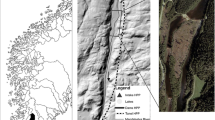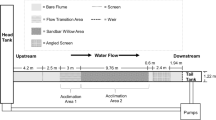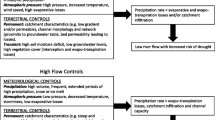Abstract
In insular Newfoundland, Canada, studies were conducted from 1999 to 2003 on the effects of ‘simulated’ hydropeaking power generation on juvenile Atlantic salmon (Salmo salar). In 1999, Atlantic salmon parr were released into an experimental reach below a hydroelectric facility and flow was manipulated over a range of discharge (1.0–4.2 m3 s−1) during a series of ‘experiments’ simulating hydropeaking in both summer and fall. Fish were implanted with radio transmitters, manually tracked, precisely located (±1 m), habitat selection evaluated, and movement response determined. Experiments were continued in 2002 and 2003 to contrast response of salmon between summer and winter, the magnitude of flow changes were greater (0.7–5.2 m3 s−1) and changes were made more rapidly (instantly). As discharge was increased, velocity and depth use by parr increased, and fish adapted behaviourally by increased contact with the substrate. Salmon parr also exhibited two distinct movement patterns in the summer and fall of 1999 studies; high site fidelity or considerable movement during trials. Salmon were more mobile during both static and dynamic flow conditions and throughout the diel cycle in the summer of 2002 experiment, and 2 fish were stranded and died, the only time this happened in the four series of experiments. Within each experiment generally there were no differences between movements at static high and low flows for day and night movements, with one exception, and night time movements were always greatest, again with one exception. During dynamic flow changes, within each experiment, distances moved during down ramping and up ramping were not significantly different except in the summer of 1999. Overall, comparing between experiments for up and down ramping events, distances moved in the summer of 2002 were statistically higher than for all other experiments. Not surprisingly, the home ranges of fish in the summer of 2002 were also the greatest while the smallest home ranges were in the winter of 2003. Results suggest hydropeaking regimes may be energetically costly potentially affecting over-winter survival which is related to energy reserves obtained during summer. Collectively these studies provide comprehensive information on the response of juvenile Atlantic salmon parr to hydropeaking, on both diel and seasonal scales, and will assist hydro producers and regulators design and operate hydropeaking regimes to minimize ecological impact.





Similar content being viewed by others
References
Armstrong, J. D., V. A. Braithwaite & F. A. Huntingford, 1997. Spatial strategies of wild Atlantic salmon parr: exploration and settlement in unfamiliar areas. Journal of Animal Ecology 66: 302–211.
Armstrong, J. D., V. A. Braithwaite & M. Fox, 1998. The response of wild Atlantic salmon parr to reductions in water flow. Journal of Animal Ecology 67: 92–297.
Arnold, G. P., P. W. Webb & B. H. Holford, 1991. The role of the pectoral fins in station-holding of Atlantic salmon parr (Salmo salar L.). Journal of Experimental Biology 156: 625–629.
Bachman, R. A., 1984. Foraging behaviour of free-ranging wild and hatchery brown trout in a stream. Transactions of the American Fisheries Society 113: 1–32.
Berland, G., T. Nickelsen, J. Heggenes, F. Okland & E. B. Thorstad, 2004. Movements of Atlantic salmon parr in relation to peaking flows below a hydropower station. River Research and Applications 20: 957–966.
Bradford, M. J, 1997. An experimental study of stranding of juvenile salmonids on gravel bars and in side channels during rapid flow decreases. Regulated Rivers: Research and Management 13: 395–401.
Bunt, C. M., S. J. Cooke, C. Katopodis & R. S. McKinley, 1999. Movement and summer habitat of brown trout Salmo trutta below a pulsed discharge hydroelectric generating station. Regulated Rivers: Research and Management 15: 395–403.
Clarke, K. D. & D. A. Scruton, 1999. Observations of juvenile Atlantic salmon Salmo salar behaviour under low temperatures in an artificial stream. In Proceedings of the 3rd International Symposium on Ecohydraulics., Salt Lake City, Utah. International Association for Hydraulic Research (on CD-ROM).
Cunjak, R. A., 1988. Physiological consequences of over wintering in streams: the cost of acclimitization? Canadian Journal of Fisheries and Aquatic Sciences 45: 443–452.
Cunjak, R. A., 1996. Winter habitat of selected stream fishes and potential impacts from land-use activity. Canadian Journal of Fisheries and Aquatic Sciences 53: 267–282.
Cunjak, R. A. & G. Power, 1987. The feeding and energetics of stream-resident trout in winter. Journal of Fish Biology 31: 493–511.
Cunjak, R. A., T. D. Prowse & D. L. Parrish, 1998. Atlantic salmon Salmo salar in winter: “the season of parr discontent”? Canadian Journal of Fisheries and Aquatic Sciences 55: 161–180.
Debowski, P. & E. Beall, 1995. Influence of dewatering on movements and distribution of salmon parr (Salmo salar L.) in relation to habitat characteristics in an experimental stream. Bulletin Francais Peche et Pisciculture 337/338/339: 267–275.
Facey, D. E. & G. D. Grossman, 1992. The relationship between water velocity, energetic costs, and microhabitat use in four North American stream fishes. Hydrobiologia 239: 1–6.
Flodmark, L. E. W., H. A. Urke, J. H. Halleraker, J. V. Arnekleiv, L. A. Voellestad & A. B. S. Poléo, 2002. Cortisol and glucose responses in juvenile brown trout subjected to a fluctuating flow regime in an artificial stream. Journal of Fish Biology 60: 238–248.
Gerking, S. D., 1953. Evidence for the concept of home range and territory in stream fishes. Ecology 34: 347–365.
Ghanem, A. H., P. M. Steffler, F. E. Hicks, C. Katopodis, 1996. Two dimensional finite element flow modeling of physical fish habitat. Regulated Rivers: Research and Management 12: 185–200.
Gore, J. A. & G. E. Petts, 1989. Alternatives in Regulated River Management. CRC Press, Boca Raton, FL.
Halleraker, J. H., S. J. Saltveit, A. Harby, J. V. Arnekleiv, H.-P. Fjelstad.& B. Kohler, 2003. Factors influencing stranding of wild juvenile brown trout Salmo trutt) during rapid and frequent flow decreases in an artificial stream. River Research and Applications 19: 589–603.
Harby, A., K. T. Alfredsen, H.-P. Fjeldstad, J. H. Halleraker, J. V. Arnekleiv, P. Borsányi, L. E. W. Flodmark, S. J. Saltveit, S. W. Johansen, K. D. Clarke & D. A. Scruton, 2001. Ecological impacts of hydro peaking in rivers. In Proceedings of the Hydropower 01 Conference. Bergen, Norway (on CD-ROM).
Heggenes, J., J. L. Baglinier & R. A. Cunjak, 1999. Spatial niche variability for young salmon Salmo salar and brown trout S. trutta in heterogeneous streams. Regulated Rivers: Research and Management 17: 623–625.
Hesthagen, T., 1990. Home range of juvenile Atlantic salmon Salmo salar and brown trout Salmo trutta in a Norwegian stream. Freshwater Biology 24: 63–67.
Hiscock, M. J., D. A. Scruton, J. A. Brown & K. D. Clarke, 2002. Winter movement of radio-tagged juvenile Atlantic salmon in Northeast Brook, Newfoundland. Transactions of the American Fisheries Society 131: 577–581.
Hutchings, J. A., 1986, Lakeward migrations of juvenile Atlantic salmon, Salmo salar. Canadian Journal of Fisheries and Aquatic Sciences 43: 732–741.
Huusko, A., L. Greenberg, M. Stickler, T. Linnansaari, M. Nykanen, T. Vehanen, S. Koljonen, P. Louhi & K. Alfredsen, 2007. Life in the ice lane: the winter ecology of stream salmonids. River Research and Applications 23: 469–491.
LeDrew L. J., D.A. Scruton, R. S. McKinley & G. Power, 1996. A comparison of habitat suitability indices developed from day time versus night time observations for Atlantic salmon in a regulated Newfoundland river. In Leclerc, M. et al. (eds), Proceedings of the Second IAHR Symposium on Habitat Hydraulics, Ecohydraulics 2000. INRS-EAU, Quebec: B33–B44.
Mäki-Petäys, A. T., A. Muotka, A. Huusko, P. Tikkanen & P. Kreivi, 1997. Seasonal changes in habitat use and preferences of juvenile brown trout, Salmo trutta, in a northern boreal river. Canadian Journal of Fisheries and Aquatic Sciences 54: 520–530.
Metcalf, N. B., F. A. Huntingford & J. E. Thorpe, 1986. Seasonal changes in feeding motivation of juvenile Atlantic salmon (Salmo salar). Canadian Journal of Zoology 64: 2439–2446.
Metcalfe, N. B., N. H. C. Fraser & M. D. Burns, 1999. Food availability and the nocturnal vs. diurnal foraging trade-off in juvenile salmon. Journal of Animal Ecology 68: 371–381.
Moog, O., 1993. Quantification of daily peak hydropower effects on aquatic fauna and management to minimize environmental impacts. Regulated Rivers: Research and Management 8: 5–14.
Morrison, H. A. & K. E. Smokorowski, 2000. The applicability of various frameworks and models for assessing the effects of hydropeaking on the productivity of aquatic ecosystems. Canadian Technical Report of Fisheries and Aquatic Sciences 2322: x + 57 pp.
Murchie, K. J. & K. E. Smokorowski, 2004. Relative activity of brook trout and walleye in response to flow in a regulated river. North American Journal of Fisheries Management 24: 1050–1057.
Peake, S., R. S. McKinley & D. A. Scruton, 1997. Swimming performance of various Newfoundland salmonids relative to habitat selection and fishway design. Journal of Fish Biology 51:710–723.
Pearson, T. N., H. W. Li & G. A. Lambert, 1992. Influence of habitat complexity on resistance to flooding and resilience of stream fish assemblages. Transactions of the American Fisheries Society 121: 427–436.
Rimmer, D. M., U. Paim & R. L. Saunders, 1983. Autumnal habitat shift of juvenile Atlantic salmon Salmo salar in a small river. Canadian Journal of Fisheries and Aquatic Sciences 40: 671–680.
Robertson, M. J., C. J. Pennell, D. A. Scruton, G. J. Robertson & J. A. Brown, 2004. Effect of short term flow fluctuations on the behaviour of Atlantic salmon parr in winter. Journal of Fish Biology 65: 1070–1079.
Saltveit, S. J., J. H. Halleraker, J. V. Arnekleiv & A. Harby, 2001. Field experiments on stranding in juvenile Atlantic salmon and brown trout during rapid flow decreases caused by hydropeaking. Regulated Rivers: Research and Management 17: 609–622.
Saunders, R. L. & J. H. Gee, 1964. Movements of young Atlantic salmon in a small stream. Journal of the Fisheries Research Board of Canada 21: 27–36.
Scruton, D. A. 1998. Changes in juvenile salmonid populations under regulated flow below a hydroelectric facility in Newfoundland Canada. In Proceedings of an International Workshop on Environmental Hydrodynamics and Ecological River Restoration in Cold Regions, SINTEF-CERI, Trondheim, Norway: 57–66.
Scruton, D. A. & R.J. Gibson, 1995. Quantitative electrofishing in Newfoundland: results of workshops to review current methods and recommend standardization of techniques. Canadian Manuscript Report of Fisheries and Aquatic Sciences 2308: vii + 148 pp, 4 Appendices.
Scruton, D. A. & L. J. LeDrew, 1997. A retrospective assessment of a regulated flow regimen for a Newfoundland (Canada) river. Fisheries Management and Ecology 4: 467–480.
Scruton, D. A., D. Perry, K. D. Clarke, A. Harby & R. S. McKinley, 1999. Validation of habitat hydraulic modeling: study of Atlantic salmon (Salmo salar) and brook trout (Salvelinus fontinalis) movements and habitat use in relation to flow changes on the West Salmon River, Newfoundland, Canada. In Proceedings of the 3rd International Symposium on Ecohydraulics. International Association for Hydraulic Research, Salt Lake City, Utah (on CD-ROM).
Scruton, D. A., K. D. Clarke, L. M. N. Ollerhead, D. Perry, R. S. McKinley, K. Alfredsen & A. Harby, 2002a. Use of telemetry in the development and application of biological criteria for habitat hydraulic modeling. Hydrobiologia 483: 71–82.
Scruton, D. A., L. M. N. Ollerhead, K. Alfredsen, K. D. Clarke, A. Harby, R. S. McKinley & D. Kelly, 2002b. Influence of seasonally and discharge explicit habitat suitability criteria on habitat hydraulic simulations and model validation. In ENVIROFLOWS 2002. Proceedings of the International Conference on Environmental Flows for River Systems, incorporating the Fourth International Ecohydraulics Symposium. International Association for Hydraulic Research, Cape Town, South Africa (on CD-ROM).
Scruton, D. A., L. M. N. Ollerhead, K. D. Clarke, C. J. Pennell, K. Alfredsen, A. Harby & D. Kelly. 2002c. The response of juvenile Atlantic salmon (Salmo salar) and brook trout (Salvelinus fontinalis) to experimental hydro peaking on a Newfoundland (Canada) river. In ENVIROFLOWS 2002. Proceedings of the International Conference on Environmental Flows for River Systems, incorporating the Fourth International Ecohydraulics Symposium. International Association for Hydraulic Research, Cape Town, South Africa (on CD-ROM).
Scruton, D. A., L. M. N. Ollerhead, K. D. Clarke, C. J. Pennell, K. Alfredsen, A. Harby & D. Kelly, 2003. The behavioural response of juvenile Atlantic salmon (Salmo salar) and brook trout (Salvelinus fontinalis) to experimental hydro peaking on a Newfoundland (Canada) river. River Research and Applications 19: 577–587.
Scruton, D. A., M. J. Robertson, L. M. N. Ollerhead, K. D. Clarke, C. J. Pennell, K. Alfredsen, A. Harby & R. S. McKinley, 2005. Seasonal response of juvenile Atlantic salmon (Salmo salar) to experimental hydro peaking power generation on a Newfoundland, Canada river. North American Journal of Fisheries Management 25: 964–974.
Shirvell, C. S., 1994. Effect of changes in streamflow on the microhabitat use and movements of sympatric juvenile coho salmon Oncorhynchus kisutch and chinook salmon O. tshawytscha in a natural stream. Canadian Journal of Fisheries and Aquatic Sciences 51: 1644–1652.
Sosiak, A. J., 1982. Buoyancy comparisons between juvenile Atlantic salmon and brown trout of wild and hatchery origin. Transactions of the American Fisheries Society 111: 307–311.
Steele, R. J. & K. E. Smokorowski, 2000. Review of literature on the downstream ecological effects of hydroelectric generation. Canadian Technical Report of Fisheries and Aquatic Sciences 2334: v + 55 pp.
Stickler, M. & K. Alfredsen, 2005. Controlling factors of anchor ice formation in two Norwegian rivers. In 13th Workshop on the Hydraulics of Ice Covered Rivers. Committee on River Ice Processes and the Environment, Hanover, New Hampshire (http://www.cripe.ca/Downloads/13th_Workshop/Stickler-Alfredsen-2005.pdf).
Tennant, D. L., 1975. Instream flow regimens for fish, wildlife, recreation and related environmental resources. U.S. Fish and Wildlife Service, Billings, Montana, USA: 30 pp.
Valdimarsson, S. K. & N. B. Metcalfe, 1998. Shelter selection in juvenile Atlantic salmon, or why do salmon seek shelter in winter? Journal of Fish Biology 52: 42–49.
Valentin, S., F. Lauters, C. Sabaton, P. Breil & Y. Souchon, 1996. Modelling temporal variations of physical habitat for brown trout Salmo trutta in hydropeaking conditions. Regulated Rivers: Research and Management 12: 317–330.
Acknowledgements
Newfoundland and Labrador Hydro assisted in this study by providing use of facilities at the Upper Salmon Hydroelectric Project and by facilitating the flow modifications. C. Kelley, C. Andrews, R. Bryant, and R. Decker (DFO), W. McCaul (University of Waterloo) provided technical assistance in the field. Research was funded by the Canadian Department of Fisheries and Oceans’ (DFO) Environmental Sciences Strategic Research Fund (ESSRF) and Natural Resources Canada’s (NRCan) Panel for Energy Research and Development.
Author information
Authors and Affiliations
Corresponding author
Additional information
Guest editors: R. L. Welcomme & G. Marmulla
Hydropower, Flood Control and Water Abstraction: Implications for Fish and Fisheries
Rights and permissions
About this article
Cite this article
Scruton, D.A., Pennell, C., Ollerhead, L.M.N. et al. A synopsis of ‘hydropeaking’ studies on the response of juvenile Atlantic salmon to experimental flow alteration. Hydrobiologia 609, 263–275 (2008). https://doi.org/10.1007/s10750-008-9409-x
Published:
Issue Date:
DOI: https://doi.org/10.1007/s10750-008-9409-x




